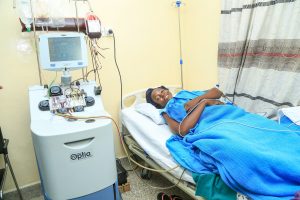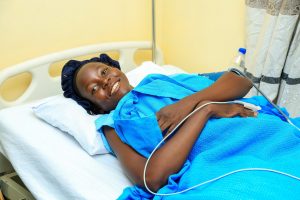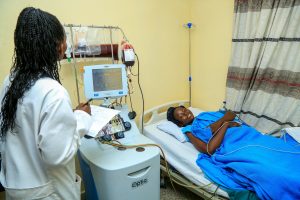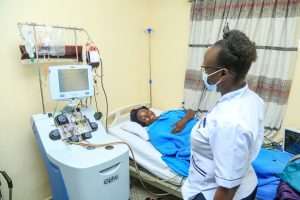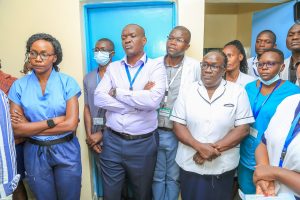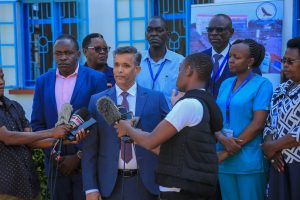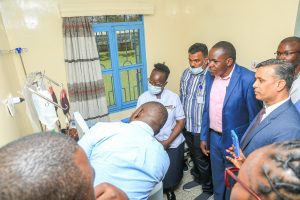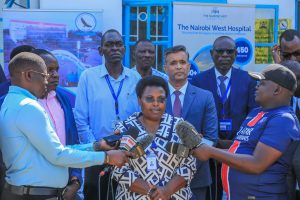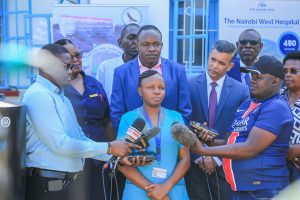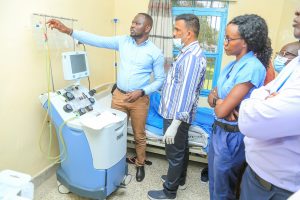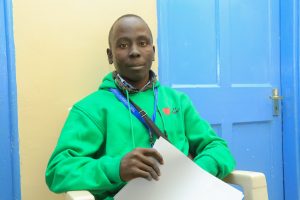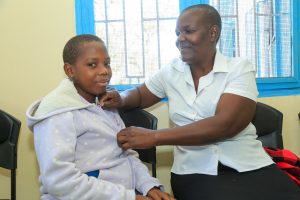Story by Sherine Atieno and Photos by Ondari Ogega
Today marked a historic moment at Victoria Hospital, an annex of Jaramogi Oginga Odinga Teaching and Referral Hospital (JOOTRH), where the first-ever automated red blood cell exchange (RBCx) transfusion was successfully performed in a Kenyan public facility.
Powered by the newly acquired apheresis machine, this breakthrough promises a brighter future for people living with sickle cell disease (SCD) by reducing painful crises, preventing strokes, and greatly improving quality of life. For some patients, the intervention can mean up to five years without a crisis, offering families a long-awaited relief.
The first person to experience this groundbreaking procedure was Mitchel Omullo, a 32-year-old filmmaker, chef, and disability inclusion facilitator who has lived with SCD since the age of three. Having received care at JOOTRH for years and founded both the West Kenya Sickle Cell Organisation and Victoria Youth in Film Empowerment, Mitchel views the treatment as a “gamechanger for warriors.” She shared, “I have suffered many crises and even two mild strokes. When I heard, this procedure was coming to Kisumu, I wanted to be part of it. The doctors at JOOTRH and Nairobi West believed in me, even covering my SHA when I couldn’t. Today, I feel renewed strength, and I encourage other warriors to embrace it.”
Mitchel’s procedure took under two hours and involved catheter insertion guided by ultrasound, followed by the transfusion of ten units of blood. Though she admitted to feeling anxious at first, she emerged hopeful and full of gratitude.
As Mitchel was receiving her treatment, other warriors had gathered at the hospital for their routine clinic visits. Among them was William Otunga, a 30-year-old clinical officer at JOOTRH who has endured five crises in the past year, the latest just in March. While processing his Social Health Authority (SHA) requirements, he expressed excitement about the apheresis machine, noting that it symbolizes “hope for a brighter future for all warriors.” Also, present was Margaret Ochieng’, whose 16-year-old daughter, Teresa, diagnosed with SCD at age four, has repeatedly missed school due to frequent crises. For Margaret, the new procedure felt like answered prayers: she said she plans to enroll Teresa for the exchange next time, hopeful that her daughter will be spared further suffering.
The gravity of this medical innovation was echoed by the hospital’s specialists. Dr. Joy Muyonga, paediatrician at JOOTRH, emphasized that without early intervention, up to 90 percent of children with SCD die before their fifth birthday—a grim reality being challenged through newborn screening and now the red blood cell exchange initiative.
Dr. Masawa Thaddeus, a clinical pathologist at JOOTRH, explained that with two machines—and sufficient blood supply—they can treat up to six patients daily. The procedure, lasting around two hours, can be repeated two to three times a year, helping to prevent strokes and improve quality of life. He further elaborated that red cell exchange is one of the most widely used therapeutic methods for patients with sickle cell disease and is particularly recommended for those with frequent painful crises, a history of stroke, or complications such as acute chest syndrome. The process works on a principle similar to dialysis for kidney patients, where the machine assumes the role of filtering blood. In this case, sickled and target cells that increase blood viscosity and clot formation are selectively removed, while plasma and white cells are returned to the patient. Donated red cells, carefully matched to the patient’s blood group, are then transfused, reducing the proportion of sickled haemoglobin (HbS) to about 30 percent. This significantly lowers the risk of complications such as stroke, painful crises, and organ damage. Dr. Masawa added that red cell exchange is also beneficial for patients suffering from chronic leg ulcers and those with recurrent vaso-occlusive episodes.
Meanwhile, Dr. Prakash Saini, Medical Superintendent of Nairobi West Hospital, highlighted the larger national impact. He noted that approximately 14,000 children are born with SCD in Kenya each year, with the highest burden in regions like Western and Nyanza. Without treatment, between 50 and 90 percent of those children in sub-Saharan Africa die before the age of five. The technology works by removing sickled cells and replenishing healthy ones, drastically reducing complications.
The leadership at JOOTRH sees this achievement as just the start of a broader vision. Mr. Joshua Okise, JOOTRH CEO, revealed that Victoria Hospital is on track to become the regional Sickle Cell and Hematology Centre, with KSh 100 million budgeted for its development. National government support and partnerships, built upon the foundation laid by Kisumu’s Governor Anyang’ Nyong’o’s leadership, will help turn that vision into reality.
The success of this program hinges on the availability of blood, which is critical for the procedure. Given that each exchange requires multiple units, public blood donation is essential. To meet this need, the JOOTRH blood transfusion unit will now operate 24/7. Additionally, warriors are encouraged to register and maintain their Social Health Authority (SHA) contributions to remain eligible for this life-saving treatment.
While sickle cell disease remains a lifelong challenge, Kisumu now stands on the verge of a future where crises no longer define the lives of its warriors.
